Crete Photos — 1
go to page 1 2
Well, not all from Crete — some are from Athens, some from airplanes. These are photos from the sabbatical month I spent mostly in the village of Kalives, at the mouth of Souda Bay on the north coast of Crete near the city of Chania.
If you click on any of the images, a larger version — still not very large (about 200kb) or very high-res — will open in a new window.
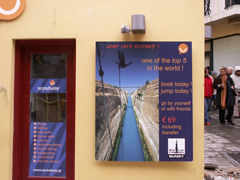
ATHENS. A travel office on Adrianou, the main tourist shopping street in Plaka under the Acropolis, offers a getaway: Bungee jumping into the Corinth Canal.
After being envisioned off and on for 2,500 years, the Canal was dug at the end of the nineteenth century to save 400 kilometers' sailing around Peloponnisos, which is therefore now an island. It's too skimpy for freighters these days (just 21 meters across), but if you want to sail your yacht or small warship through it, you can study this list of fees.
Narrow as it is, the Canal is pretty impressive to look at or, I imagine, to jump into. It's about 50 meters deep, with about eight meters of water in it, which I suppose might help, but not really. Still, the tourists coming down that sidestreet on the right may be tempted once they round the corner and decide they've seen enough reduplicated discus-throwers, emphatically priapic ceramic satyrs, and T-shirts emblazoned Δεν ελπίζω τίποτα, δεν φοβάμαι τίποτα, είμαι ελέυθερος ("I hope for nothing, I fear nothing, I am free" — Kazantzakis' epitaph). Red Shoes looks ready.
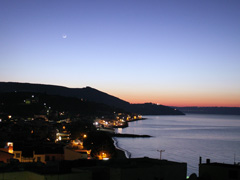
KALIVES. This is the town on the north shore of Crete where I lived during May, 2006. We're looking west (that moon is setting) along Souda Bay toward the big NATO port, which that faint string of lights on the far shore probably marks; about ten kilometers beyond that, across the isthmus where the bulbous Akrotiri Peninsula sprawls north around the bay, is the city of Chania.
On the high headland that separates us from all that, the little rectangular nipple is a Turkish fort; below that to the right is a village, Kalami "fishing-pole"), and between them runs the National Highway — no lights visible at the moment in its tiny red notch. Kalives spreads along the shore, all beach. Its dark mole juts out northward into the bay toward Souda Island and Akrotiri.
I took this from the balcony I inhabited, from which I took (at a guess) 150 of that month's 1,507 photos were taken. (Next slide, please.)

ATHENS. The Acropolis, as seen in the rear-view mirror of a motorcycle parked in Plaka.
In the lower right corner of the reflection is a bit of the octagonal Tower of the Winds: Boreas, Kaikias, Apeliotes,Euros, Notos, Lips, Zephyros, Skiron. (Boreas the North Wind is facing us; Skiron the Northwest, with his vat of ashes, is on our left.) It was a nice motorcycle, 250cc, parked against one of Athens's innumerable marble flowerboxes.
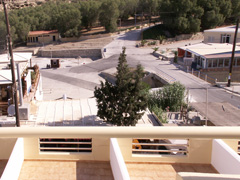
MATALA. Let me see if I can explain. Matala (stress on the first syllable) is a small village on the south coast of Crete. Zeus, as bull, carried Europa to its beach; he'd been born a dozen miles north. It became the port of the Minoan city of Phaistos after Kommos burned down or silted in or something like that. The limestone cliff that's the north wall of the tiny crescent harbor is full of rows of Neolithic caves that the Romans used as tombs.
Then for a long time nothing happened — that is, people kept living there for almost 2,000 more years without anyone else much noticing, until the hippies discovered the place during the sixties. There was a Life Magazine cover feature on it, and Joni Mitchell has told stories of being there.
At some point, the city fathers or mothers decided to make the best of this new popularity — the town certainly quadruples in summer, and summer's long there — and accommodate the tourists, rather than continuing to try to pretend they're not there (as you can see them doing in the background of a couple of the Life photos). To this end, aside from what's by now quite a crowd of hotels, they made a parking lot. You can see it down there, below my hotel balcony, including the little shack for the guard who arrives early on his motorbike to collect one euro per day per car.
The odd thing is its location. The parking lot is convenient to the beach of course (just out of the picture to the left), and easily accessible by that little concrete bridge that abuts the main road into town. But the bridge bridges a substantial concrete trough not unlike the L.A. River. For several months every year, the parking lot must be waist-deep; and that bit of valley bed, during "twenty centuries of stony sleep," must have been a waste land.
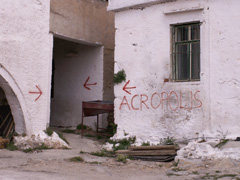
POLYRRINIA. Not that Acropolis. Since the word means "city peak", summit, extreme tippy-top, every defensible city-state had one or, in hard times, was one.
The acropolis pointed to by these very clear and emphatic indicators is that of a site far in the west of Crete, about eight kilometers inland from the city of Kissamos, which is also called Kasteli, and which was once a port of Polyrrinia. A very small village occupies this high ground now, but the ancient citadel, starting in the fifth or sixth century B.C., must have controlled a lot of surrounding territory.
Because it's out of the way of crowds, there's no entrance fee, nor the kind of tourist infrastructure that embraces (or smothers) Knossos and Phaistos. In short, these signs are helpful, forestalling the embarrassment that results when visitors wander into people's private courtyards, so difficult sometimes to tell from squares and streets in a Greek town.
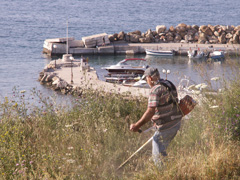
KALIVES. From the balcony: The weeds by the hotel were growing gloriously thick over the late-spring weeks. On the day before a wedding was performed at the chapel just up the hill — a chapel that had never been open before — a wedding that occasioned quite a lot of (first) honking and (later) gunfire presumably into the air — this guy came and muscled it all down. He was fierce, Hephaistos with an odd job.
Behind him, the tiny fishing port is visible; it's a kind of working appendage to the mostly lounging sprawl of the Kalives beach. It's about twenty meters below him and a hundred meters behind him, I guess.
